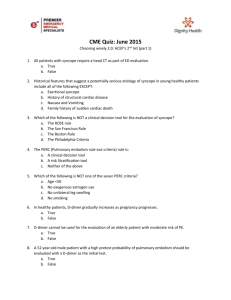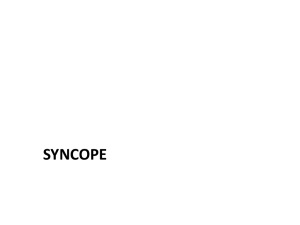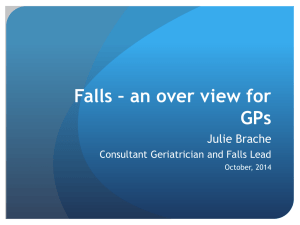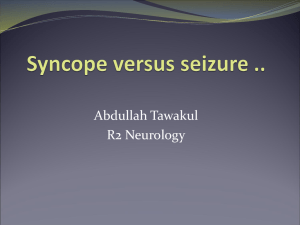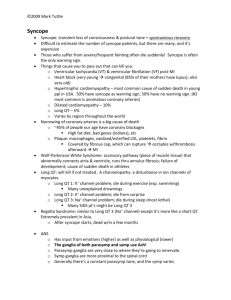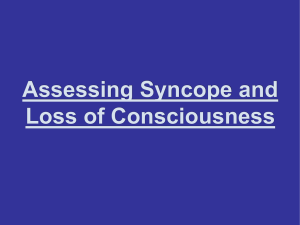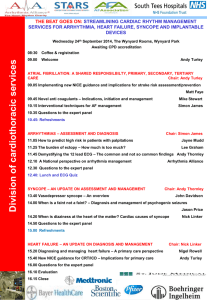Emergency Medicine—The Differential Diagnosis
advertisement
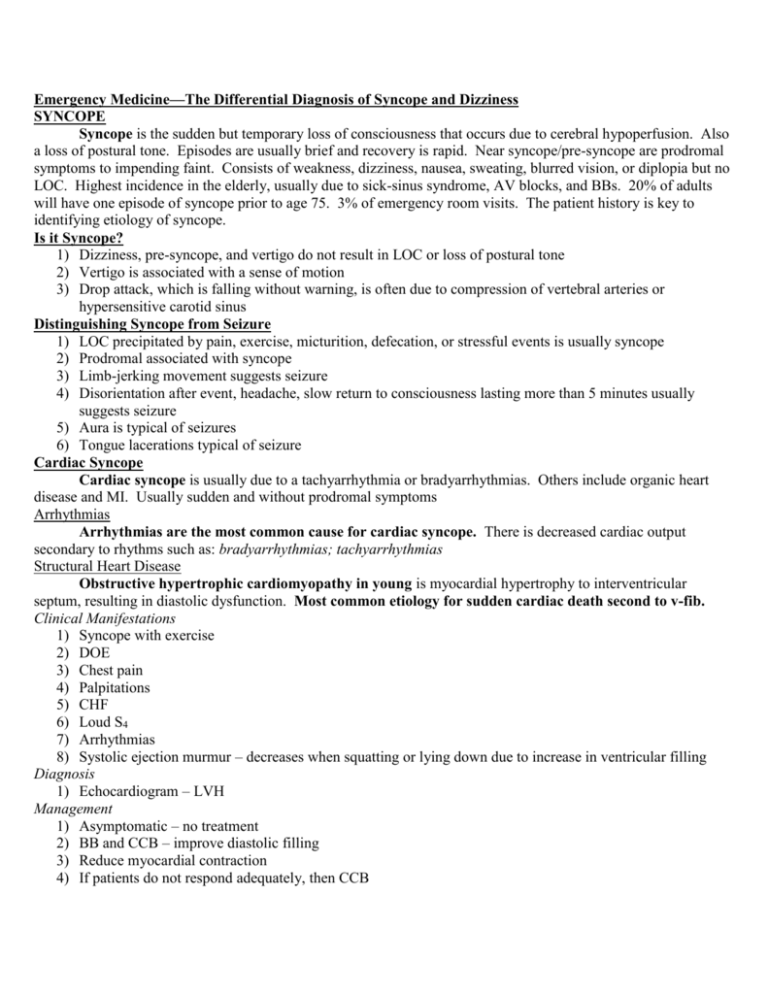
Emergency Medicine—The Differential Diagnosis of Syncope and Dizziness SYNCOPE Syncope is the sudden but temporary loss of consciousness that occurs due to cerebral hypoperfusion. Also a loss of postural tone. Episodes are usually brief and recovery is rapid. Near syncope/pre-syncope are prodromal symptoms to impending faint. Consists of weakness, dizziness, nausea, sweating, blurred vision, or diplopia but no LOC. Highest incidence in the elderly, usually due to sick-sinus syndrome, AV blocks, and BBs. 20% of adults will have one episode of syncope prior to age 75. 3% of emergency room visits. The patient history is key to identifying etiology of syncope. Is it Syncope? 1) Dizziness, pre-syncope, and vertigo do not result in LOC or loss of postural tone 2) Vertigo is associated with a sense of motion 3) Drop attack, which is falling without warning, is often due to compression of vertebral arteries or hypersensitive carotid sinus Distinguishing Syncope from Seizure 1) LOC precipitated by pain, exercise, micturition, defecation, or stressful events is usually syncope 2) Prodromal associated with syncope 3) Limb-jerking movement suggests seizure 4) Disorientation after event, headache, slow return to consciousness lasting more than 5 minutes usually suggests seizure 5) Aura is typical of seizures 6) Tongue lacerations typical of seizure Cardiac Syncope Cardiac syncope is usually due to a tachyarrhythmia or bradyarrhythmias. Others include organic heart disease and MI. Usually sudden and without prodromal symptoms Arrhythmias Arrhythmias are the most common cause for cardiac syncope. There is decreased cardiac output secondary to rhythms such as: bradyarrhythmias; tachyarrhythmias Structural Heart Disease Obstructive hypertrophic cardiomyopathy in young is myocardial hypertrophy to interventricular septum, resulting in diastolic dysfunction. Most common etiology for sudden cardiac death second to v-fib. Clinical Manifestations 1) Syncope with exercise 2) DOE 3) Chest pain 4) Palpitations 5) CHF 6) Loud S4 7) Arrhythmias 8) Systolic ejection murmur – decreases when squatting or lying down due to increase in ventricular filling Diagnosis 1) Echocardiogram – LVH Management 1) Asymptomatic – no treatment 2) BB and CCB – improve diastolic filling 3) Reduce myocardial contraction 4) If patients do not respond adequately, then CCB 5) Avoid strenuous activity Aortic Stenosis in Elderly Aortic stenosis in the elderly leads to obstruction to LV outflow. Cardiac output cannot increase. Clinical Manifestations 1) Syncope following exercise 2) LVH 3) Triad – dyspnea, chest pain, syncope 4) Dyspnea first followed by orthopnea, syncope on exertion, angina, and MI 5) Crescendo-decrescendo systolic murmur, S4 6) Precordial thrill 7) EKG – LV is consistent with CHF Treatment 1) Hospitalize to evaluate for valve replacement Neurology Etiology Subclavian Steal Syndrome Subclavian steal syndrome is stenosis of the subclavian artery proximal to the origin of the vertebral artery. Exercise of the left arm leads to backward flow of blood down the ipsilateral vertebral artery to fill the subclavian artery distal to stenosis Clinical Manifestations 1) Symptoms of vertebral basilar arterial insufficiency – headache, n/v, dizziness, diplopia, “drop attack” 2) Brachial symptoms – arm pain and paresthesia 3) BP left arm < right arm 4) Decreased pulse in left arm Diagnosis 1) Angiography or Doppler Management 1) Surgery – bypass the stenosis and form collateral circulation between the subclavian and the vertebral arteries Carotid Sinus Hypersensitivity Carotid sinus hypersensitivity is due to pressure on a sensitive carotid sinus by a tight collar or neck mass. Leads to vagal stimulation, inhibiting sympathetic tone. Diagnosis 1) Symptoms are reproduced with pressure on the carotid sinus for 5-10 seconds with patient supine. Treatment 1) Remove source of pressure 2) Atropine for bradyarrhythmias Orthostatic Syncope Orthostatic syncope in the inability to raise heart rate adequately and increase peripheral resistance adequately, resulting in syncope. Orthostatic syncope results from sitting to standing as well as medications such as anti-hypertensive medications, diuretics, blood loss, DM (autonomic neuropathy), dehydration, and aortic dissection Clinical Manifestations 1) History of sudden standing or prolonged standing 2) Lightheadedness 3) Dimming of vision 4) Weakness 5) Fainting sensation Diagnosis 1) Orthostatic vital changes 2) Positive tilt table test Management 1) Increase sodium and oral intake 2) IV fluids if dehydration suspected 3) Hospitalize only if postural hypotension cannot be correct Vasovagal Syncope Vasovagal syncope is the most common cause of syncope. Use caution in diagnosing this in patients >40 years old. Normal compensatory response is an increase in sympathetic tone. Here, parasympathetic response is greater. Precipitating factors include emotional upset, sight of blood, prolonged motionless standing, medical procedures, and early pregnancy. Clinical Manifestations 1) Anticipation – initial sympathetic response prior to parasympathetic response 2) Prodrome of weakness, lightheadedness, nausea, fatigue, diaphoresis, blurred vision, and pallor. 3) Syncope Diagnosis 1) Tilt table test to reproduce symptoms – gold standard Management 1) Supine position and elevate legs 3) Good prognosis 2) Beta-blockers Other Etiology Psychogenic 1) Anxiety 3) Panic disorder 2) Conversion reaction Situational 1) Coughing 4) Swallowing 2) Defecation 5) Micturition 3) Eating Medications Hypotensive Agents 1) Nitrates 3) Anti-hypertensives 2) Diuretics Psychoactive Drugs 1) PTZ 3) Barbiturates 2) TCAs 4) Narcotics Others 4) Ethanol 1) Digitalis 2) Insulin 5) Cocaine 3) Marijuana Diagnosis of Syncope 1) Treat more important things first 2) Etiology due to cardiac or non-cardiac reason 3) History – events prior to, during, and post syncope episode 4) PE – orthostatic vital signs, mental status, murmurs, and carotid bruits 5) Pressure to Carotid Sinus 9) Holter monitor 6) EKG 10) Tilt table Test 7) CBC 11) Carotid Doppler 8) Metabolic panel 12) Echocardiogram Differential Diagnosis 1) MI 3) Stroke 2) Seizure 4) Shock Complications 1) Cardiac etiology associated with death 2) Associated with injury from the fall Unknown Etiology – Disposition If causes of syncope not readily apparent after initial clinical evaluation, admit patients: 1) Elderly 4) Family history of syncope or sudden death 2) Sudden syncope in non-standing patients 5) Evidence of structural heart disease by history 3) Syncope during exertion or exam DIZZINESS Vertigo Vertigo is a disturbance in vestibular system. It is an illusion of movement. They will claim that the room is spinning. Two types: peripheral vertigo and central vertigo. Central Vertigo 1) Involves the brain stem and cerebellum 2) Etiology is drugs, cerebellar mass or stroke, encephalitis, multiple sclerosis 3) Onset is gradual, less intense, and constant 4) No hearing loss or tinnitus 5) CNS symptoms usually present Peripheral Vertigo 1) Peripheral to the brain stem – can involve the vestibular apparatus or CN VIII 2) Onset is abrupt, intense, paroxysmal, with N/diaphoresis, hearing loss, tinnitus, and no CNS symptoms 3) Usually benign Benign Positional Vertigo Benign positional vertigo is the MCC of vertigo in patients >60. Otoliths, which are normally attached to the utricle, become dislodged and enter the posterior semicircular canal where they drag endolymph with movement, leading to vertigo. Resolves as the otoliths dissolve. Associated with position change and resolves within 1 minute. Patient should be asymptomatic if no head movement. Acoustic Neuroma Acoustic neuroma arises from the vestibulocochlear nerve (CN VIII). Vestibule is for balance and the cochlea is for hearing. There is a gradual onset of hearing loss from days-weeks. Usually only affects one side. Patient will have hearing loss and tinnitus. Symptoms worsen as tumor progresses centrally. Diagnosed by CT scan. Treatment is surgery Meniere’s Disease Meniere’s disease is an imbalance in secretion and absorption and endolymph fluid that causes buildup of fluid in cochlea. Swelling leads to damage. Associated with low frequency hearing loss and tinnitus and vertigo. Usually unilateral. It is episodic vertigo for 24-48 hours. Sensorineural hearing loss is low frequency. Patient will present with tinnitus, fullness/pressure in ears, n/v/dizziness. Diagnose with CT scan Labyrinthitis Labyrinthitis is a viral infection that affects the cochlea and labyrinth. Vestibular neural input is disrupted to the cerebra cortex and brainstem. Patients have vertigo due to inflammation and infection of labyrinth. Neurological exam in normal. Usually lasts 7-10 days. Present with n/v, vertigo with head or body movements, nystagmus that is rotary away from the affected ear, loss of balance with fall toward affected side, tinnitus, and normal CNS assessment Peripheral vs. Central Vertigo Clinical Manifestations 1) Head movement does not affect central vertigo 2) Complete ear exam – hearing is not decreased in central vertigo 3) Cranial nerves – can be abnormal with both 4) Cerebellar function – loss in central vertigo 5) Nystagmus – horizontal or rotary in peripheral vertigo. Central nystagmus might be vertical or horizontal Diagnosis 1) CT scan Treatment 1) Nausea and poor fluid intake require fluids 2) Peripheral vertigo – Meclizine, Promethazine for symptomatic relief 3) Meniere’s disease – HCTZ, valium, tigan, antivert 4) Labyrinthitis – steroids, antivert, and tigan 5) Central vertigo requires imaging studies and neurology referral Near Syncope Near syncope is a feeling of oncoming syncope. Due to hypoperfusion of the brain. Etiology is orthostasis, cardiac disease, vasovagal episode, and environment Clinical 1) Pallor 3) Nausea 2) Diaphoresis Management 1) Lay patient flat Disequilibrium Disequilibrium is the feeling of falling while walking. Etiology is often cervical spondylosis and cerebellar disease. Psychogenic Psychogenic causes of syncope include major depression, general anxiety disorder, and panic disorder. Could be due to malingering Clinical Manifestations 1) Lack of prodrome 2) Lack of pallor and prolonged unconsciousness 3) In coma, ice water on TM will lead to no movement of eyes, movement of eyes towards the side being irrigated 4) In psychogenic, ice water will induce nystagmus or cause patient to awaken Differential Diagnosis 1) Stroke 4) Brain tumor or bleeding in the brain 2) Multiple sclerosis 5) Cardiac arrhythmias, heart attack 3) Seizure 6) Shock
